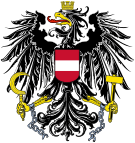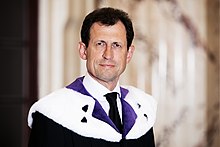
The chancellor of the Republic of Austria is the head of government of the Republic of Austria. The position corresponds to that of Prime Minister in several other parliamentary democracies.

The president of Austria, officially titled federal president of the Republic of Austria is the head of state of the Republic of Austria. Though theoretically entrusted with great power by the Constitution, in practice the president is largely a ceremonial and symbolic figurehead.

Ernst Streeruwitz was an Austrian military officer, businessman, political scientist and politician. A member of the industrialist wing of the Christian Social Party, Streeruwitz served on the National Council from November 1923 to October 1930 and as chancellor and foreign minister from May to September 1929.

The Federal Constitution of Austria is the body of all constitutional law of the Republic of Austria on the federal level. It is split up over many different acts. Its centerpiece is the Federal Constitutional Law (Bundes-Verfassungsgesetz) (B-VG), which includes the most important federal constitutional provisions.

A district is a second-level division of the executive arm of the Austrian government. District offices are the primary point of contact between residents and the state for most acts of government that exceed municipal purview: marriage licenses, driver licenses, passports, assembly permits, hunting permits, or dealings with public health officers for example all involve interaction with the district administrative authority.

Johannes "Johann" Schober was an Austrian jurist, law enforcement official, and politician. Schober was appointed Vienna Chief of Police in 1918 and became the founding president of Interpol in 1923, holding both positions until his death. He served as the chancellor of Austria from June 1921 to May 1922 and again from September 1929 to September 1930. He also served ten stints as an acting minister, variously leading the ministries of education, finance, commerce, foreign affairs, justice, and the interior, sometimes just for a few days or weeks at a time. Although Schober was elected to the National Council as the leader of a loose coalition of Greater German People's Party and Landbund near the end of his career, he never formally joined any political party. Schober remained the only chancellor in Austrian history with no official ideological affiliation until 2019, when Brigitte Bierlein was appointed, becoming the first woman to take office.

The judiciary of Austria is the system of courts, prosecution and correction of the Republic of Austria as well as the branch of government responsible for upholding the rule of law and administering justice. The judiciary is independent of the other two branches of government and is committed to guaranteeing fair trials and equality before the law. It has broad and effective powers of judicial review.

In Austrian politics, the Federal Chancellery is the ministry led by the chancellor. Since the establishment of the First Austrian Republic in 1918, the Chancellery building has served as the venue for the sessions of the Austrian cabinet. It is located on the Ballhausplatz in the centre of Vienna, vis-à-vis the Hofburg Imperial Palace. Like Downing Street, Quai d'Orsay or – formerly – Wilhelmstrasse, the address has become a synecdoche for governmental power.
A mandatory referendum, also known as an obligatory referendum, is a referendum that is legally required to be held under specific circumstances. This is in contrast to an optional referendum, which comes from either by public or legislative request. The actions that require mandatory referendums are set by law and normally concern major governmental actions or matters of large public significance. The most commonly found example worldwide of a mandatory referendum is a required referendum to adopt or amend a national constitution, which exists in many countries.
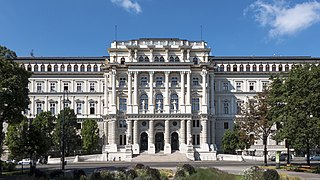
The Supreme Court of Justice is the final court of appeal of Austria in civil and criminal matters. Along with the Supreme Administrative Court and the Constitutional Court, it is one of Austria's three apex courts.
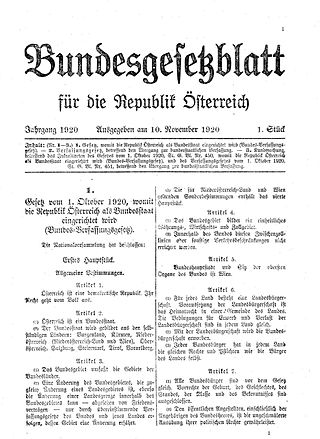
The Federal Constitutional Law is a federal constitutional law in Austria serving as the centerpiece of the Constitution. It establishes Austria as a democratic federal parliamentary republic.
The December Constitution is a set of six acts that served as the constitution of the Cisleithanian half of Austria-Hungary. The acts were proclaimed by Emperor Franz Joseph on 21 December 1867 and functioned as the supreme law of the land until the collapse of the empire in 1918. Five of the Constitution's acts were replaced by the Federal Constitutional Law between 1918 and 1920; the sixth law, a bill of rights, is still in force.

The European and Austrian constitutions endow the Austrian court system with broad powers of judicial review. All Austrian courts are charged with verifying that the statutes and ordinances they are about to apply conform to European Union law, and to refuse to apply them if not. A specialized Constitutional Court checks statutes for compliance with the Austrian constitution and executive ordinances for compliance with Austrian law in general.

In the Republic of Austria, the Supreme Administrative Court is the appellate court to which appeals may be made from the decisions of the country's eleven administrative trial courts. The Supreme Administrative Court also resolves demarcation disputes within the administrative court system and hears complaints about administrative trial courts that fail to issue verdicts legally required of them in a timely manner.
Bernd-Christian Funk is an Austrian legal scholar and educator. Funk is a former professor of Constitutional and Administrative Law at the University of Vienna, the dean and academic director of the Sigmund Freud University Vienna Faculty of Law, and one of the governors of the Medical University of Innsbruck.
Theodor Öhlinger was an Austrian constitutional scholar and educator. Öhlinger was a member the Austrian Constitutional Court from 1977 to 1989 and a professor of constitutional and administrative law at the University of Vienna from 1974 to 2007. From 1999 until his death, he served as the deputy chairman of the board of trustees of the Vienna Museum of Art History. Öhlinger published 23 books and more than 350 scholarly articles and appeared as a frequent commentator on legal issues in the Austrian news media. Austrian President Alexander van der Bellen called him Austria's "operating system" during the turbulent times of May 2019.

In Austrian politics, the Streeruwitz government was a short-lived right-of-center coalition government led by Ernst Streeruwitz, in office from May 4, 1929 to September 26, 1929. The coalition consisted of the Christian Social Party, the Greater German People's Party, and the Landbund. Although its majority in the National Council was narrow, it was a broad alliance sociologically; the coalition represented much of the middle class as well as most of the agricultural sector, along with banking and industrial interests. Its main opponents were the Social Democratic Party to the left and the extra-parliamentary Heimwehr movement to the right.
In Austrian politics, the Breisky government was a caretaker cabinet in office from ca. midday of January 26 to ca. midday of January 27, 1922. The government came to be when Chancellor Johannes Schober stepped down in order to put a formal end to a coalition agreement between Christian Social Party and Greater German People's Party that had gradually broken down over the course of the preceding weeks. President Michael Hainisch installed Walter Breisky, the vice chancellor in Schober's cabinet, as Schober's interim successor. Within less than twenty-four hours, the quarreling coalition partners agreed that no credible alternative to Schober was available, revived their coalition agreement, and convinced Schober to take the reins again.
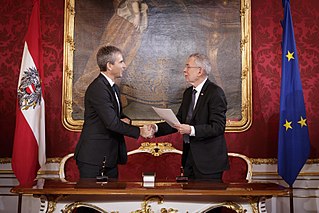
In Austria, a minister is a member of the Cabinet that usually leads a ministry or a division of the Chancellery.

In Austrian constitutional law, a supreme executive organ , is an elected official, political appointee, or collegiate body with ultimate responsibility for a certain class of administrative decisions – either decisions in some specific area of public administration or decisions of some specific type. The president, for example, is the supreme executive organ with regards to appointing judges; the minister of justice is the supreme executive organ with regards to running the prosecution service; the president of the Constitutional Court is the supreme executive organ with regards to the operational management of the Constitutional Court. The Constitutional Court itself, on the other hand, is not a supreme organ because its decisions, while definitive, are judicial and not administrative in nature.


